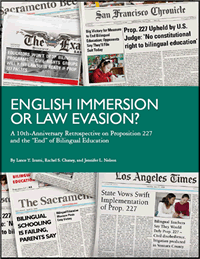On June 2, 1998, Californians overwhelmingly passed Proposition 227, which significantly limited bilingual education for students not fluent in English in favor of structured English immersion (SEI). Bilingual education emphasizes the use of the native language of English-language-learner (EL) students for instruction in core subjects, while SEI requires teachers to teach primarily in English. Since its passage, key questions about 227 have focused on whether it has been effective in improving English-language acquisition among EL students and how effectively and faithfully schools have implemented it.

In the 10 years since the measure became law, even some former opponents of Proposition 227 have changed their stance in the face of improving assessment results. Yet the struggle still continues over implementation.
Whether from perverse monetary incentives or a commitment to pro-bilingual ideology, opponents of 227 continue to promote bilingual education at the expense of English immersion programs. Some school officials at local levels have been slow to implement the new programs, and some policy makers continually search for loopholes to undermine 227’s intent. Further, some state university schools of education continue to promote bilingual education in their teacher training programs.
California voters have every right to be distressed by the continued foot-dragging in implementing a law that they enacted using the tools of an open and participatory democratic system. Regardless of how one feels about the merits of 227 and its effects since its passage, the bottom line is that Proposition 227 is California law and should be upheld, in letter and spirit. The rule of law is paramount in a democracy, and voters have the right to expect laws they enact to be implemented, not ignored or defied.
It should also be noted that in 1986, voters overwhelmingly passed Proposition 63, which made English the official language of California. Proposition 63, the California English Language Amendment, prevailed by 73 percent to 27 percent, a landslide margin.

